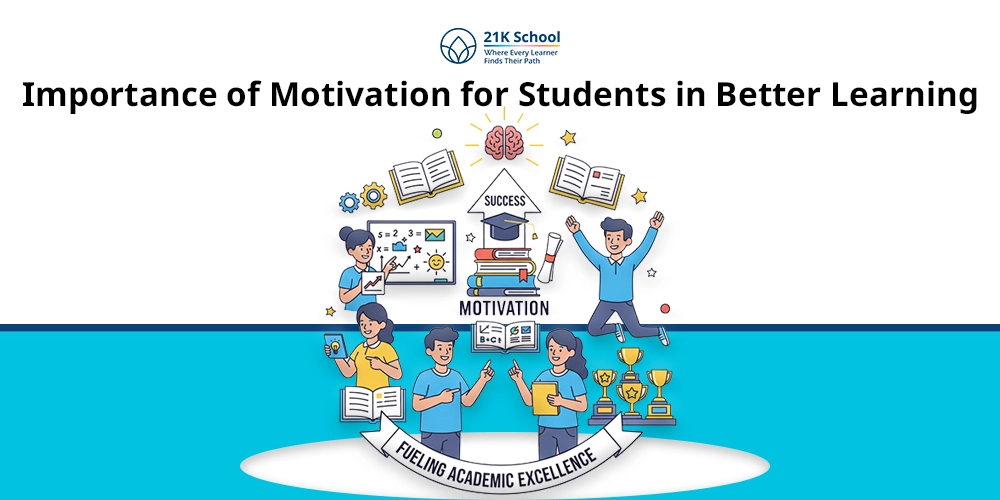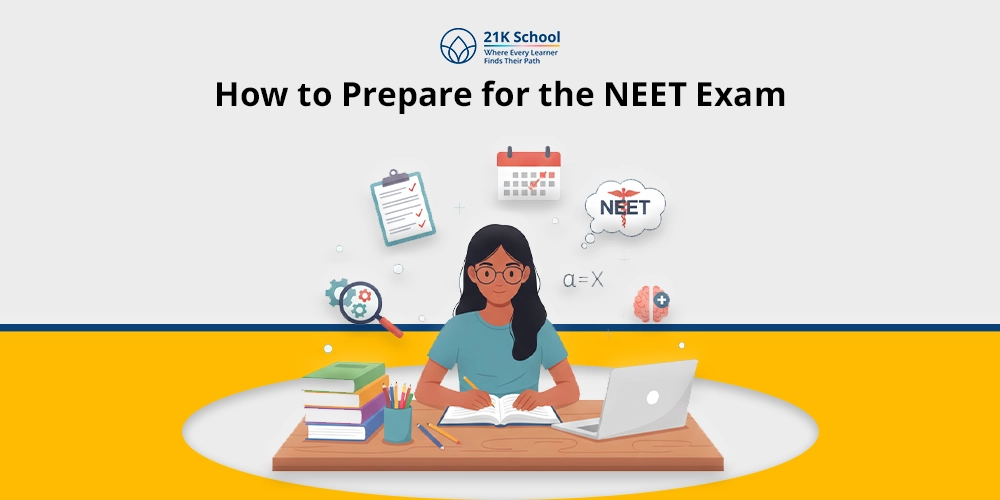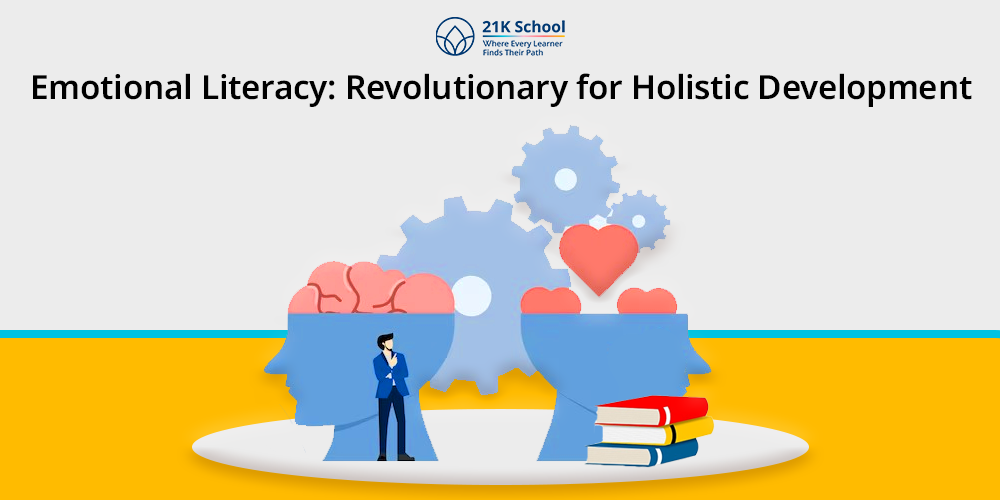
Emotional literacy is the capacity to understand, express, and relate to feelings and emotions of others and oneself. It is also an important ability that allows individuals to move easily within their own emotions and relate well with others.
Over the past several years, emotional literacy has become an area of special concern in educational, psychological and professional spheres. With a consistent focus on the importance of social emotional learning , it is set to influence well-being, relations and accomplishments in many fields of life.
This paper will learn about emotional literacy, and what it means in various ages of life, whether it is in childhood or adulthood. We shall also explore the emotional literacy-scale and the use of emotional competencies.
Contents
- What is Emotional Literacy?
- Emotional Literacy Scale
- Elements of Emotional Literacy
- What is the Significance of Emotional Literacy?
- How to Teach Emotional Literacy to Students?
- 1. Mindfulness
- 2. Construct Feelings Vocabulary
- 3. Label Feelings
- 4. Expressing Emotions Appropriately
- 5. Improved Social skills
- 6. Model Emotional Awareness
- 7. Emotional Literacy Programs
- 8. Practice Empathy
- 9. Active-Listening
- 10. Be A Fine Example
- 11. Emotion Charades
- 12. Get Them to Speak
- 13. Self-Calm and Self-Regulate
- 14. Self-Awareness
- 15. Social Awareness
- 16. Role-Play Exercises
- 17. Emotional Story Telling
- 18. Problem Solving
- Emotional Literacy vs Emotional Intelligence
- Challenges and Barriers of Emotional Literacy
- Applications of Emotional Literacy in Real Life
- Conclusion
What is Emotional Literacy?
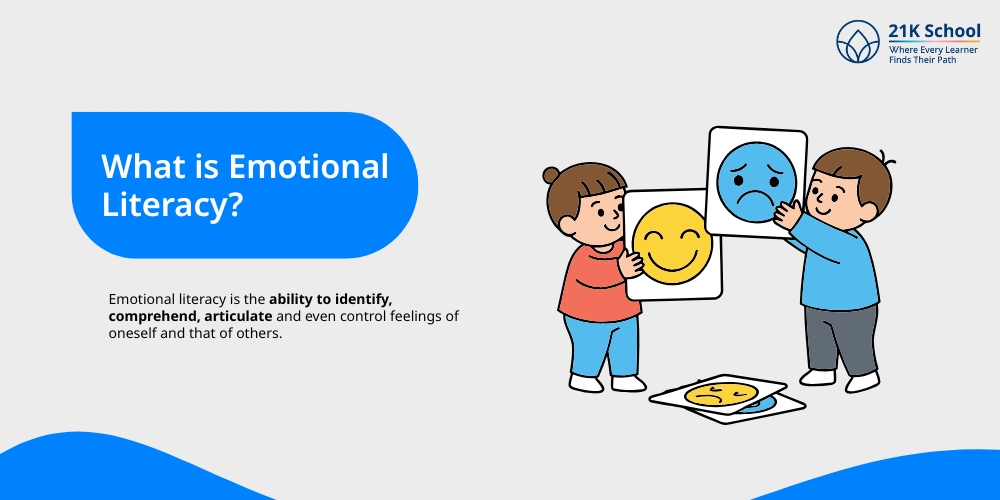
Emotional literacy is the ability to identify, comprehend, articulate and even control feelings of oneself and that of others. It is regarded as the root of emotional intelligence (EI) popularized by the psychologist Daniel Goleman.
Although emotional intelligence embraces more general skills like motivation and social skills . Emotional literacy focuses on the language of emotion, naming our emotions, expressing them well, and acting positively in response.
Claude Steiner coined the term in the 1990s. He would later believe that emotional literacy is not inborn but a set of skills which can be learned and elaborated.
Steiner defined it as a group of abilities which help to understand and manage emotions in a productive and healthy way.
In more ordinary words, emotional literacy would allow individuals to:
- Recognize what they are feeling
- Understand why they feel that way
- Communicate their emotions appropriately
- Empathize with others
- Regulate emotional responses in different situations
Emotional literacy is not always prioritized in a formal education as opposed to general literacy that is taught in schools. Nevertheless, it significantly affects the quality of life of a person, and relations.
Emotional Literacy Scale
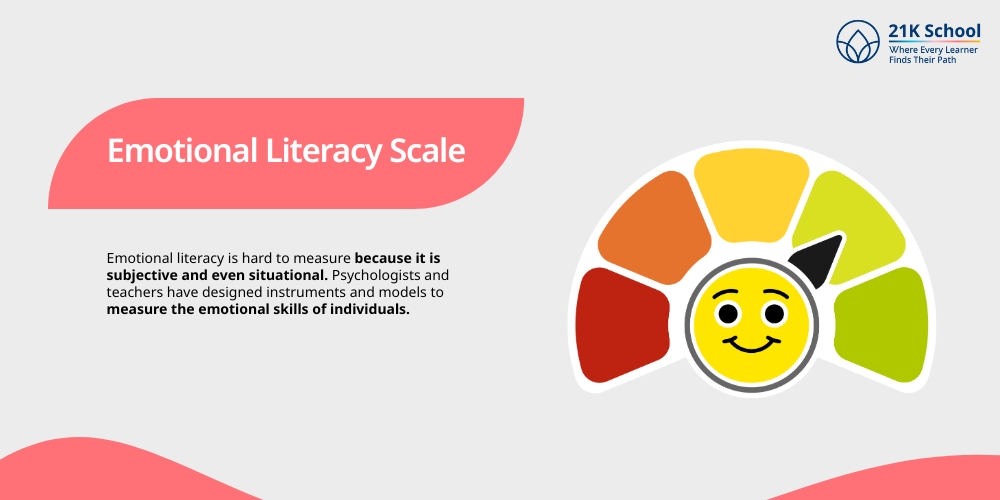
Emotional literacy is hard to measure because it is subjective and even situational. Nevertheless, psychologists and teachers have designed instruments and models to measure the emotional skills of individuals.
These normally overlap into five major dimensions:
1. Self awareness: Having knowledge of how one feels and how these feelings affect them.
2. Self-regulation: The ability to deal with disruptive emotions and impulses.
3. Motivation: An effective disposition to go after the aims with force and perseverance.
4. Empathy: The power to perceive the feelings of other people.
5. Social skills: These are skills of dealing with people and network building.
Don’t forget to practice these self-awareness activities for students , helping them become their better versions.
Particular tools are:
- Emotional Literacy Assessment and Intervention Tool (ELAIT): Created on the basis of the children and applied in the work of educators and therapists.
- Emotional Literacy Skills Scale: This is a common assessment of emotional awareness, empathy, motivation, social skills, etc. It contains elements according to the Turkish version of this scale.
- The Emotions Scale: Measures the emotional reasoning and insight with the help of a likert scale. It is usually used for children and youngsters to identify and rate the intensity of emotions.
Emotional literacy is commonly measured by the use of self-report questionnaires, scenario-based assessment, and teacher/peer reports. They aid in determination of strengths and areas requiring improvement, which may prove particularly useful in educational and organizational environments.
Elements of Emotional Literacy
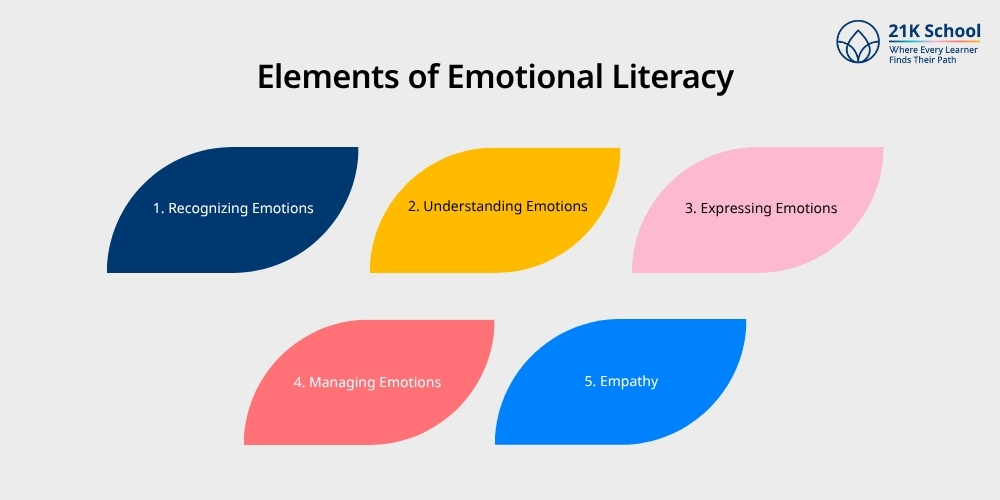
Emotional literacy can be divided into a few key areas which are all effective in the provision of emotional competence. These elements are usually mutually related, and the change in one will usually result in change in others.
1. Recognizing Emotions
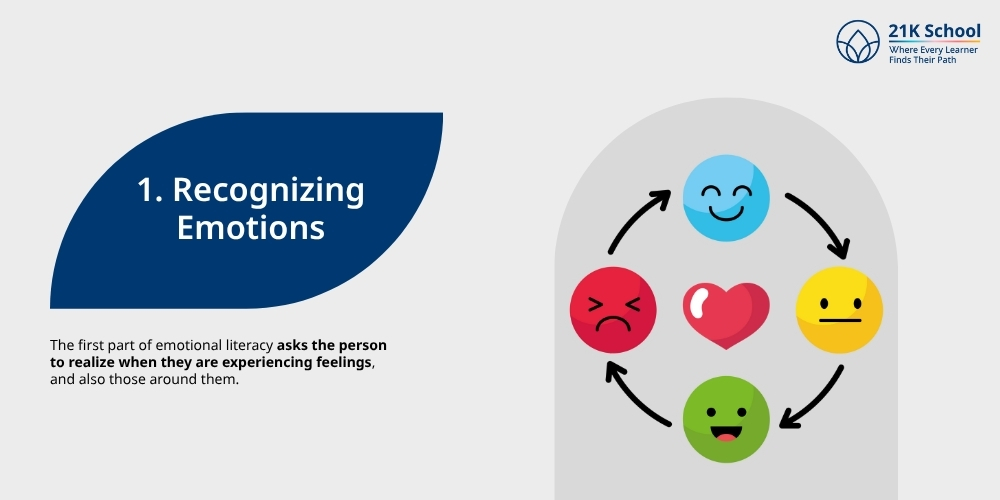
The first part of emotional literacy asks the person to realize when they are experiencing feelings, and also those around them. Here we recognize the physical signals like facial expressions, body language, tone of voice, and other behavioral signals.
As an example, the raised voice can mean anger, and the downcast eyes can mean sadness. Understanding of emotions is attributed to some extent of self-awareness and understanding of other people.
Individuals with strong skills in the identification of emotions can easily know how to behave in a social setup. As an illustration, when somebody looks angry, it may be an indicator that they feel anxious or dejected and one can support them.
2. Understanding Emotions
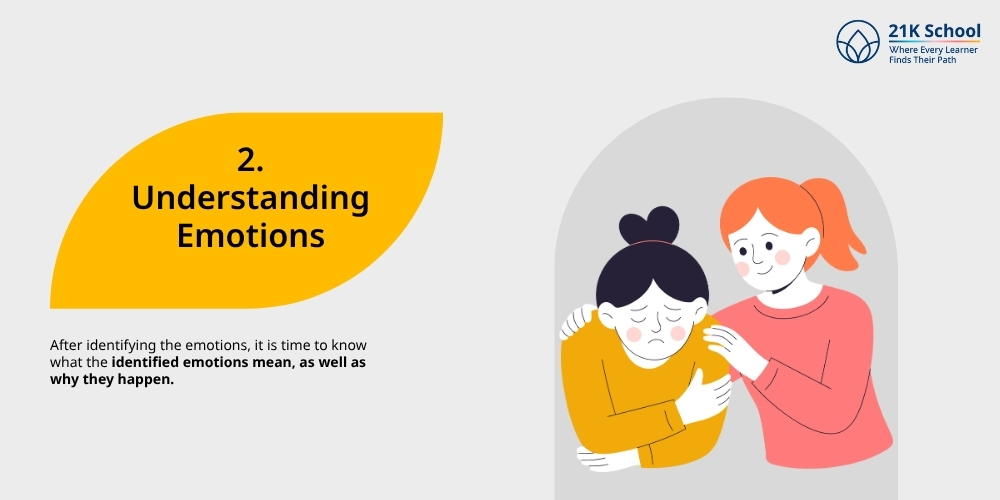
After identifying the emotions, it is time to know what the identified emotions mean, as well as why they happen. It has to do with understanding the nature of emotional life, including his or her own and that of other people.
Emotional understanding is contented with understanding that emotions are complex. And individuals can have more than one emotion at one time (e.g., being sad and happy about a change in life).
Being emotionally literate is the ability to know how emotions impact upon thoughts, behaviors, and choice of action. This consciousness enables one to make adequate sense of his or her emotional experiences, rather than letting them distort this view of reality.
3. Expressing Emotions
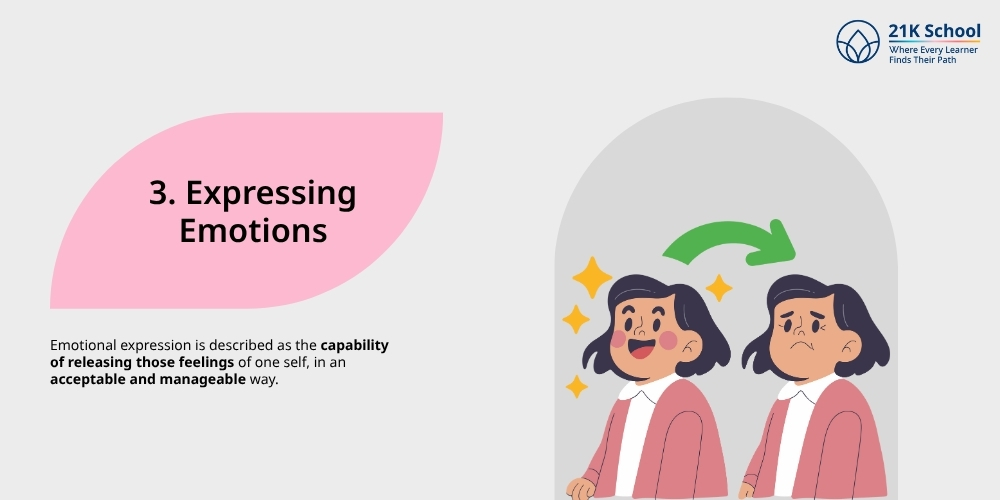
Emotional expression is described as the capability of releasing those feelings of one self, in an acceptable and manageable way. It involves the employment of sound, gestures and delivery to express feelings.
Healthy emotion expression helps individuals to feel understood, decreases misunderstandings and brings about positive relationships. Take the example of being frustrated, when one is frustrated it is much better to air it out constructively.
Say something like “I feel frustrated” because I did not understand the instructions rather than bottle it up or vent out by exploding in anger.
4. Managing Emotions
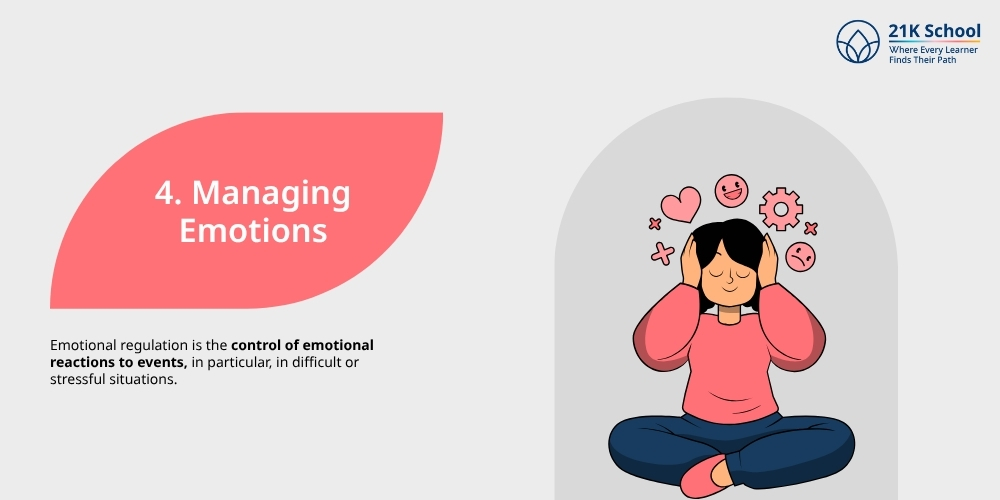
Emotional regulation is the control of emotional reactions to events, in particular, in difficult or stressful situations. It is all about managing impulsive responses, remaining composed even when challenges appear. And being equipped with methods to relax or improve the mood.
People who possess skills in emotional regulation better cope with misfortune, manage stress, and experience a balanced emotional state better. This is an important skill both in terms of personal health, a valid relationship and making wise decisions.
5. Empathy
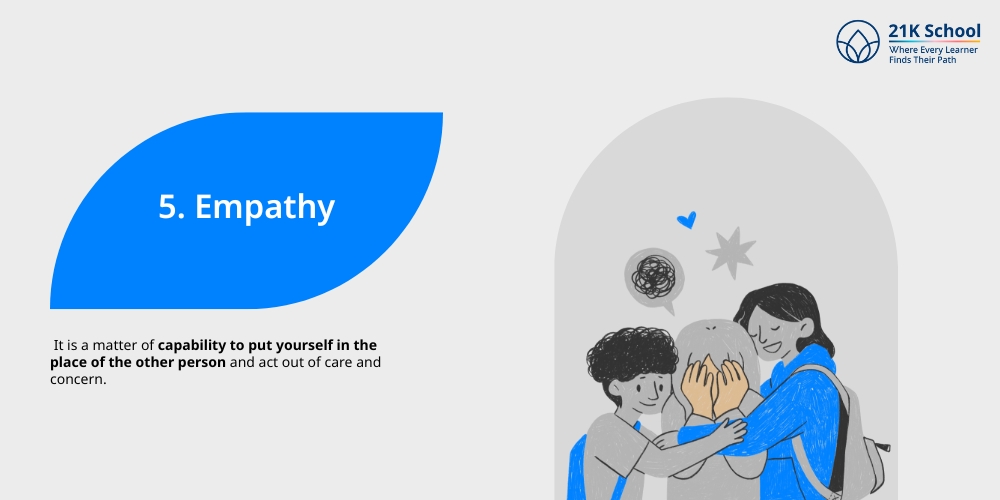
Empathy refers to the capacity to get the feelings of someone and have a share in it. It is a matter of capability to put yourself in the place of the other person and act out of care and concern.
Empathy is very important in trust-building, forming connections and conflict resolving. Both understanding someone and feeling what they feel can be called empathy: the cognitive view and the emotional one.
The two kinds belong to social and emotional development. This is true in the case where it is done when the person is grieving; such an empathetic attitude can be very therapeutic.
Therefore, it is crucial that educators and parents are aware of how to develop empathy in a child .
What is the Significance of Emotional Literacy?
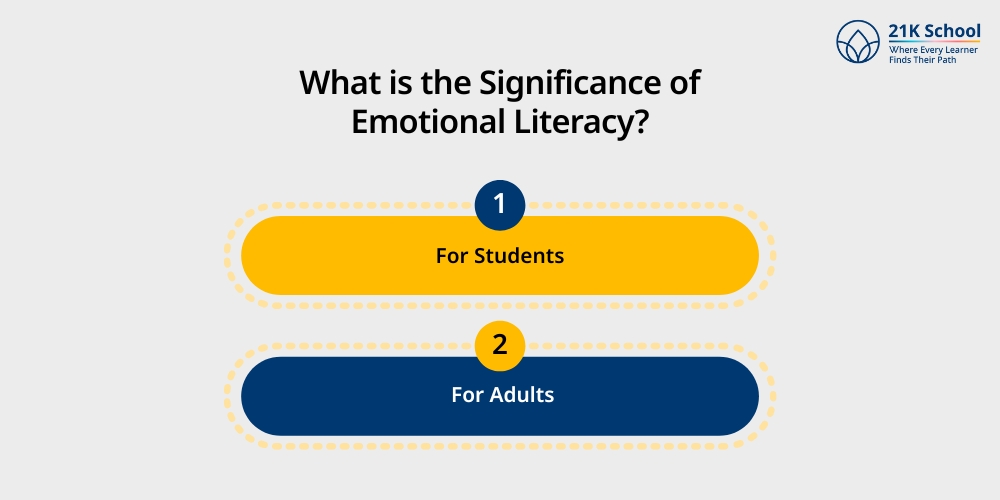
Emotional literacy is a key to all personal and social development. It has the potential of causing high emotional well-being, improved decision-making and improved relationships. Let us see why emotional literacy is crucial in school and adult life.
1. For Students
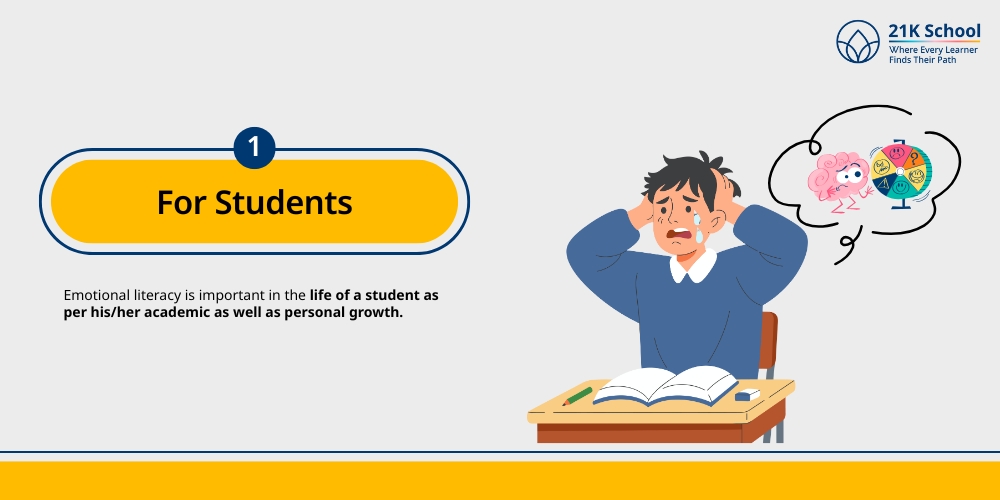
Emotional literacy is important in the life of a student as per his/her academic as well as personal growth. Emotionally literate children and adolescents perform better at school, their self-esteem is higher and they have less-concerning behavioral patterns.
There are certain advantages like:
- Better grades: Temper regulation enables students to concentrate on their studies reduce anxieties during tests and become more active in classroom activities.
- Improved relations: By possessing emotional literacy, students are able to establish and sustain positive relations with fellow students and teachers .
- Conflict resolving abilities: They can solve differences more without being confrontational or distancing.
- Resilience: They are even better in handling failures, bullying, or family problems. This reflects better student mental health .
The schools with Social and Emotional Learning (SEL) programs have better-behaved students, less student punishment, and more inclusive school environments.
2. For Adults
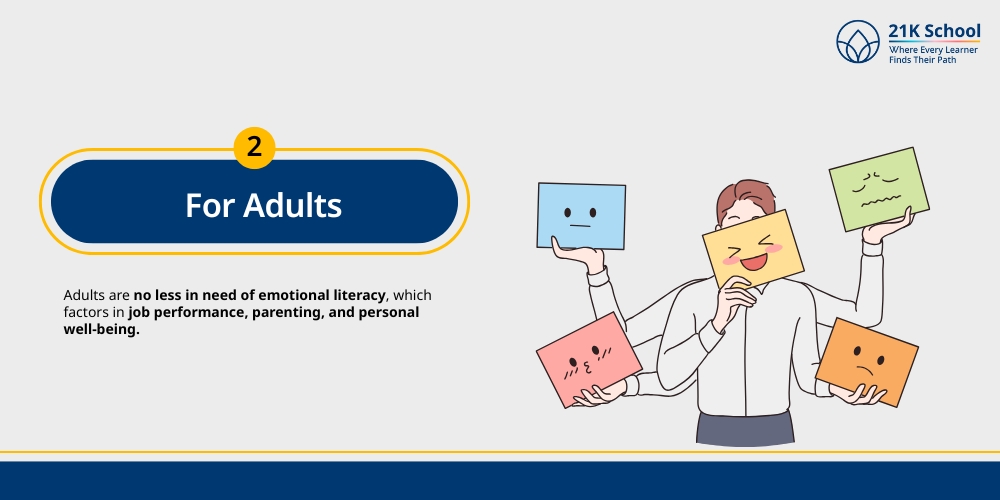
Adults are no less in need of emotional literacy, which factors in job performance, parenting, and personal well-being. Emotionally literate adults make better leaders, more efficient communicators, and have more emotional stability.
The major benefits are:
- Success at the workplace: Emotionally literate individuals are able to manage in market politics, cope up with workplace stress and practice teamwork.
- Parenting effectiveness: Emotionally literate parents can demonstrate healthy behaviours and can encourage and help their children to develop them.
- Mental health: The person can recognize and control his or her emotions as an adult, which reduces any risk of anxiety, depression, or burnout.
- Relationship satisfaction: Emotional literacy enhances relationships by having better communication, understanding and solving conflicts.
Emotionally literate adults develop surroundings that are conducive, nurturing and effective in relationships, workplaces and communities.
How to Teach Emotional Literacy to Students?

Emotional literacy in students is important in promoting emotional well-being, social competency and academic achievement. Through providing students with the means to know, articulate and control their emotions.
Teachers and parents can guide students through the maze of social relationships and personal issues. Emotional literacy is also useful in enhancing mental health, minimizing conflict, whether within or outside the classroom.
These are some of the ways how to make students develop emotional literacy:
1. Mindfulness
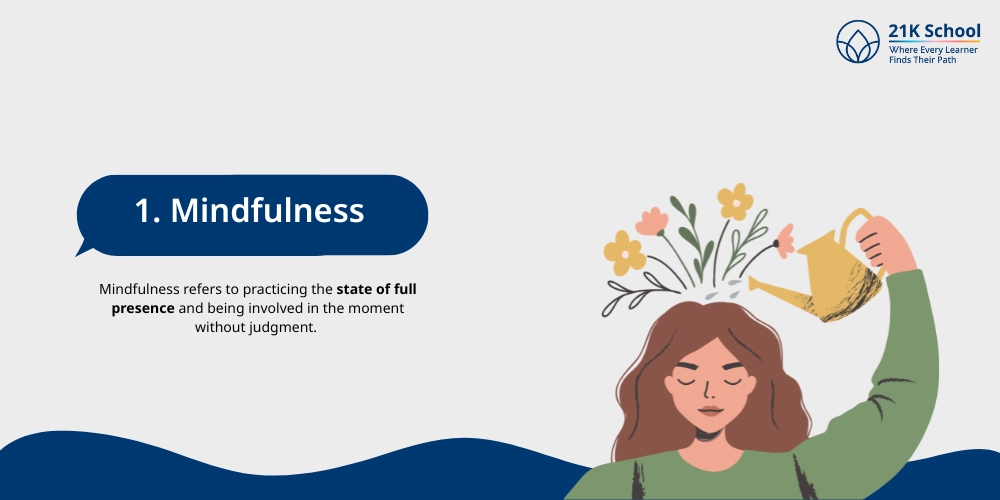
Mindfulness refers to practicing the state of full presence and being involved in the moment without judgment. It makes students be more attentive to their emotions, thoughts, and physical sensations as they appear, making them self-aware.
Deep breathing, guided imagery or simple meditation practices can assist the students in building emotional awareness and control the emotional reactions. Mindfulness in the classroom can lead to calm, concentration and emotional steadiness that is necessary in emotional literacy.
2. Construct Feelings Vocabulary
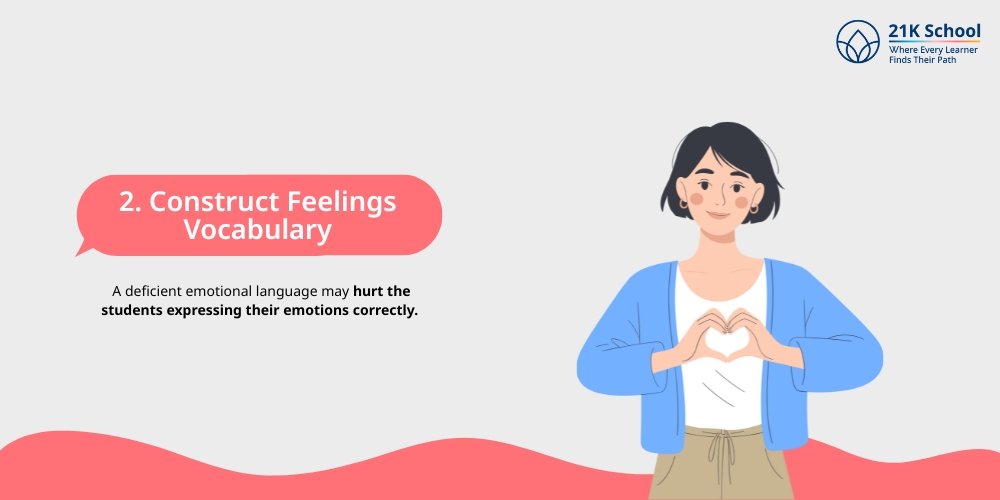
A deficient emotional language may hurt the students expressing their emotions correctly. The ability to teach students about a huge variety of emotional words, including simple ones or more complicated ones should be cultured.
Emotions like happy, sad and such as frustrated, confused, or disappointed can assist students in describing what they are feeling.
The more words students possess to explain their feelings, the more they are able to share their inner world and comprehend the worlds of others. This can be achieved by using social emotional learning activities like, use of emotion word charts, flashcards or story telling exercises.
3. Label Feelings

A very important action in emotional literacy is labeling of emotions. By aiding students to identify and name their feelings, one will promote emotional awareness and lead to improved emotional control.
Students also need a positive learning environment to be able to release their feelings and accept them without condemnation. In a classroom setting, the labeling can be taught by simply asking the students how they feel or what they are feeling.
4. Expressing Emotions Appropriately
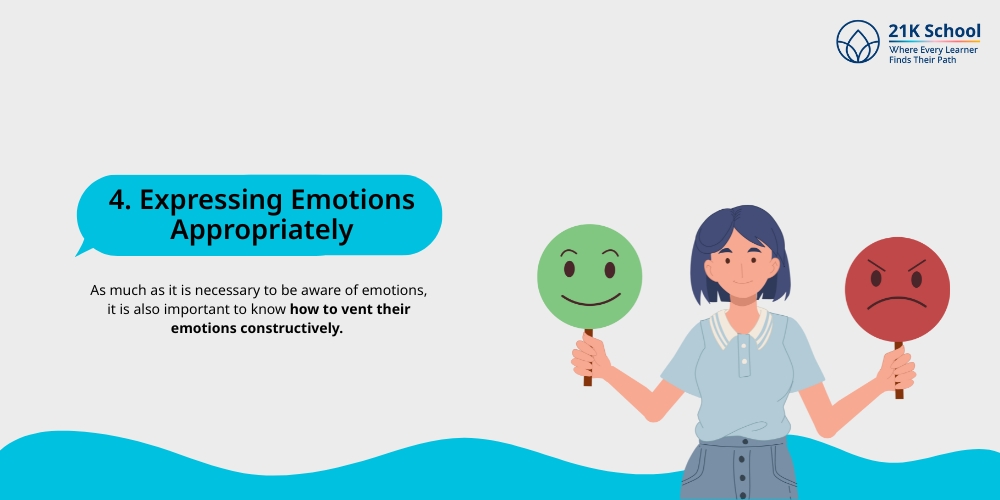
As much as it is necessary to be aware of emotions, it is also important to know how to vent their emotions constructively. The students should be taught how to express their emotions in a positive way.
Give students examples of how they can express various emotions properly. As an example, when you are angry, it could be better instead of yelling and behaving out of control to say, “I am angry, because I was not given what I wanted”.
The ability to communicate effectively their feelings in the social environment allows students to establish positive relationships and prevents conflicts. Now that’s where it becomes vital to teach the importance of communication skills to students.
5. Improved Social skills
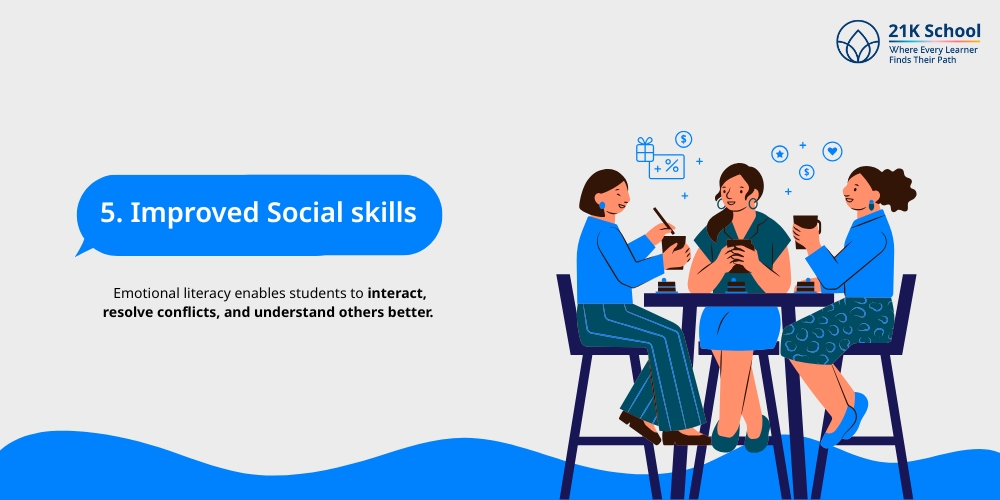
The idea of emotional literacy is closely connected to the issue of social skills. Emotional literacy enables students to interact, resolve conflicts, and understand others better.
The skills that are vital in teaching students to have healthy relationships with peers are cooperation, turn taking and problem-solving skills .
Group discussions, collaborative learning or team-building exercises can help students to act jointly and rehearse their social skills. That too without neglecting and disrespecting the emotions of others.
6. Model Emotional Awareness
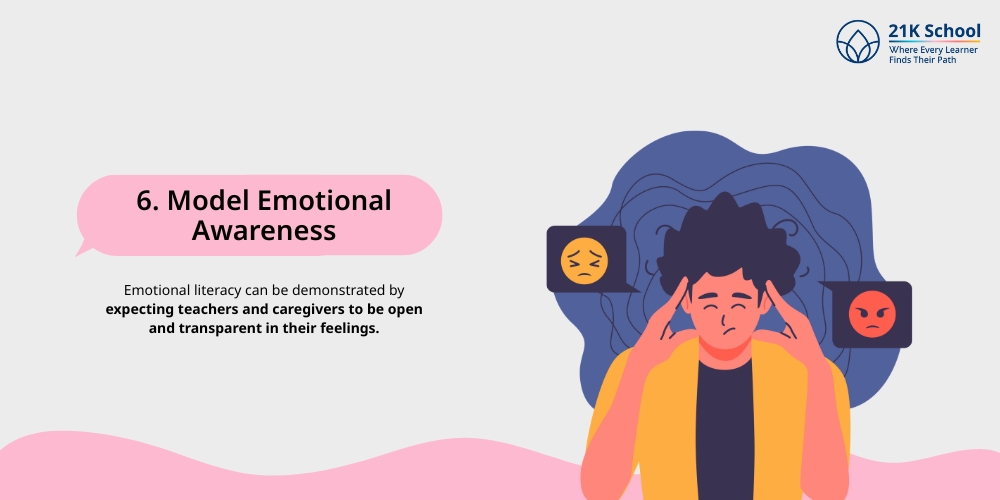
Emotional literacy can be demonstrated by expecting teachers and caregivers to be open and transparent in their feelings. Students will emulate positive, constructive behavior in expressing their feelings when they observe model behavior in adults.
As an example, a teacher may say, “I feel frustrated that things are not moving according to plan but I will take a deep breath and see how I will work out a solution.” This will give the students a practical demonstration of the way to deal with emotions in a positive way.
7. Emotional Literacy Programs
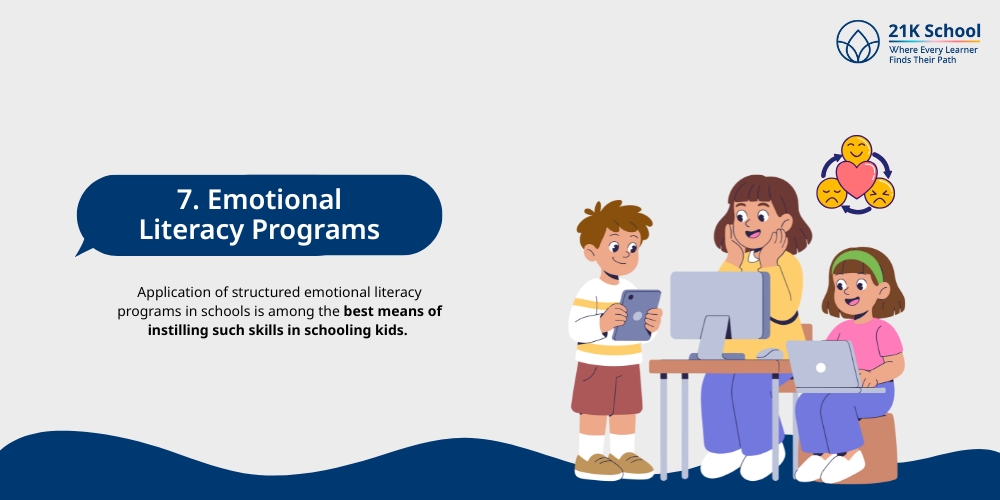
Application of structured emotional literacy programs in schools is among the best means of instilling such skills in schooling kids. Social-emotional learning (SEL) programs emphasize self-awareness, self-management, social awareness, relationship skills and responsible decision-making.
Most SEL programs offer teachers and students resources and tools that would encourage them to develop emotional literacy. Curriculum materials, activities and lessons of these programs usually aim to help students comprehend their feelings and learn to express them.
It also develops empathy and positive social skills.
8. Practice Empathy
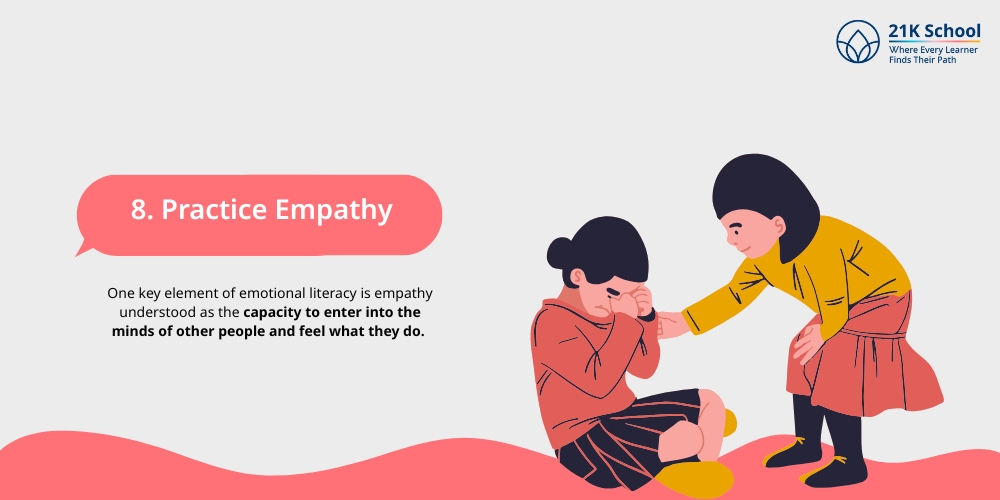
One key element of emotional literacy is empathy understood as the capacity to enter into the minds of other people and feel what they do. This can help learners become more empathetic, understand, and balance other perspectives and thus form better emotional attachments.
Putting oneself into the shoes of others can be taught through empathy activities. These include narratives or talk about instances where individuals feel a variety of emotions.
Asking the students to wonder how the other person would experience a situation is a good practice of empathy.
9. Active-Listening
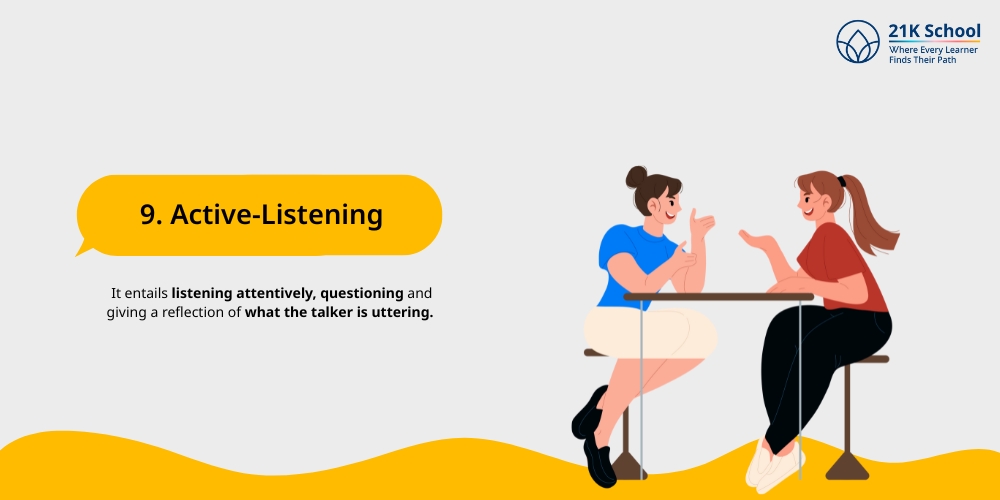
One of the core skills that could define emotional literacy is referred to as active listening . It entails listening attentively, questioning and giving a reflection of what the talker is uttering.
Students should be encouraged to listen by giving them hope to express their feelings or thoughts and asking them to listen without interruption. This should also be demonstrated by the teachers by acting responsively to the student concerns where they are empathizing with them.
10. Be A Fine Example
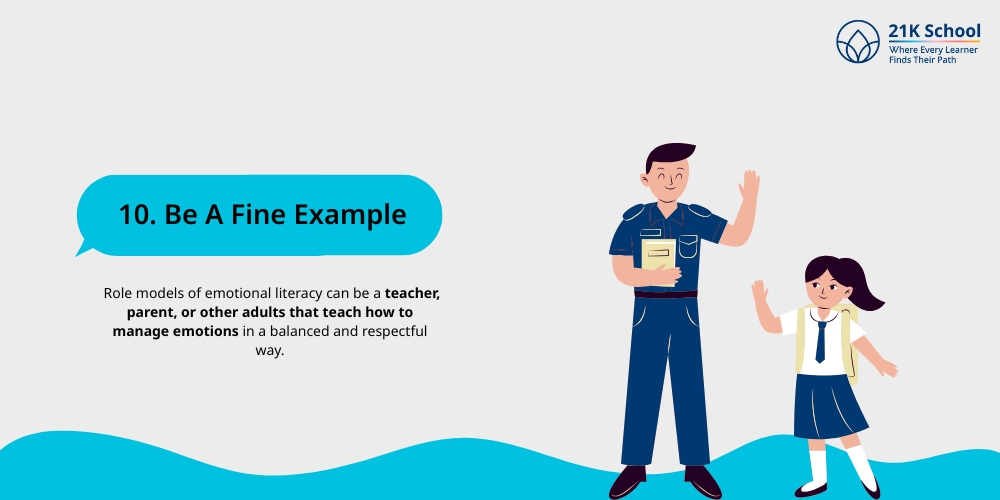
By observing the behaviors of the people around them, students learn a lot. Role models of emotional literacy can be a teacher, parent, or other adults that teach how to manage emotions in a balanced and respectful way.
As an example, a teacher can say, when faced with a stressful situation, I feel overwhelmed then I will take the time and reflect. And how about that all of us should have a good deep breath together?”
This portrays good emotional control and proves that it is normal to feel a certain kind of emotion, as long as one controls emotions well.
11. Emotion Charades
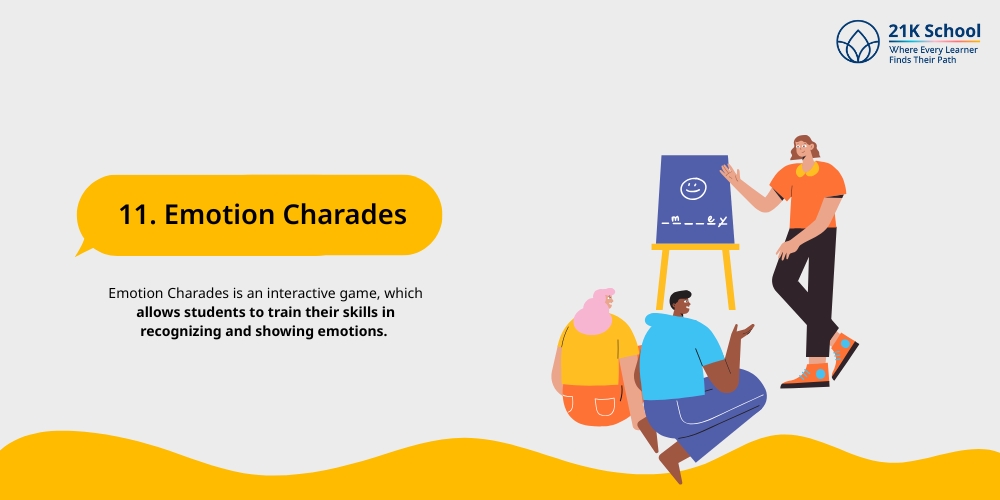
Emotion Charades is an interactive game, which allows students to train their skills in recognizing and showing emotions. During this activity, students portray various emotions– happy, sad, angry, surprised and scared, etc without talking and their classmates attempt to identify the emotion.
The non-verbal cues linked with various emotions are also something that this game makes students think about deeply. And a student has an opportunity to act out their own emotions in a safe, non-threatening environment.
12. Get Them to Speak
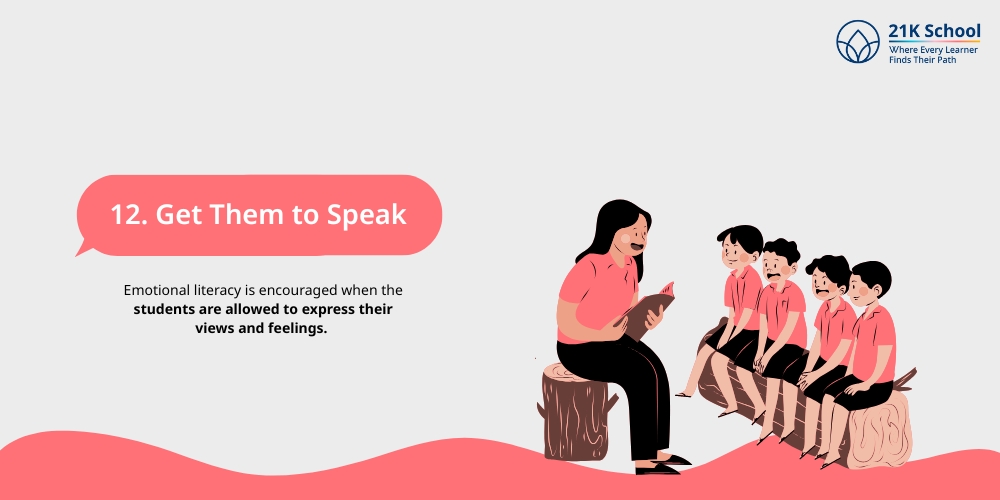
Emotional literacy is encouraged when the students are allowed to express their views and feelings. Educators will be able to establish an environment in which students do not feel afraid to talk about how they feel.
Embarking on practice to integrate emotional discussions into the classroom regularly. These might be having a circle of feelings, or just asking students how they are, can go a long way to make writing about emotions a regular thing and dispel stigma.
13. Self-Calm and Self-Regulate
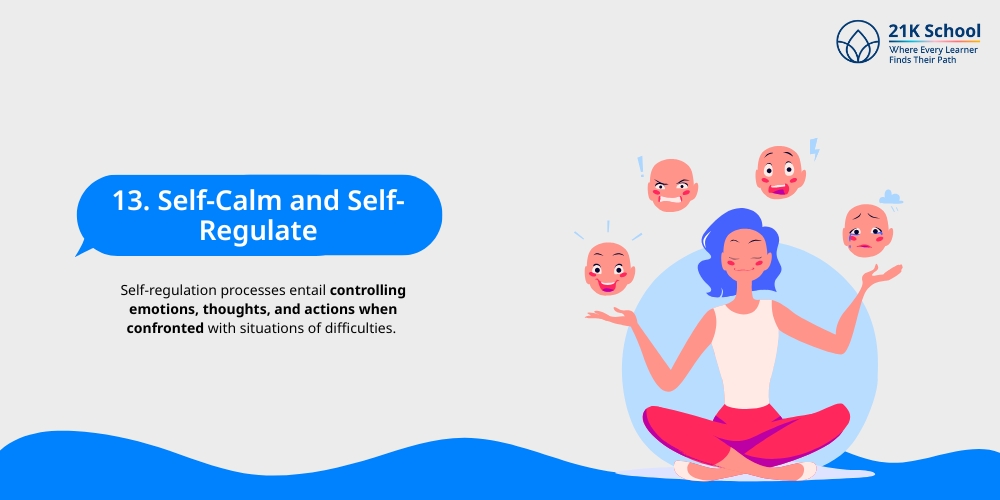
Self-regulation processes entail controlling emotions, thoughts, and actions when confronted with situations of difficulties. Students can be trained to calm down; they could learn to use deep breathing, imagery, or counting to ten when they are stressed, angry or frustrated.
Such strategies are especially useful in high-stress circumstances, like when students become conflicted with peers or are under academic pressure. Giving students the means to manage their emotions makes them calm down and remain focused whether they are in the classroom or outside it.
Self-regulated learning gives an upper hand for students practicing emotional regulation in themselves.
14. Self-Awareness
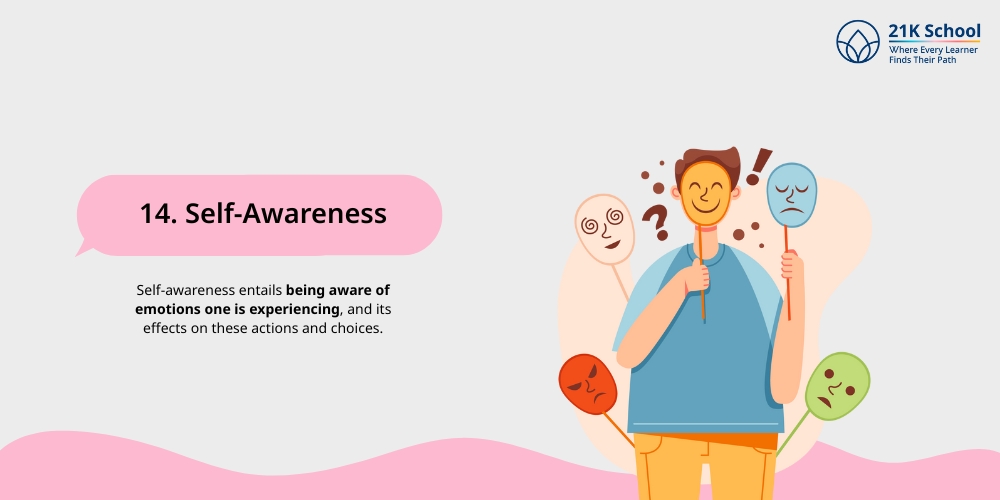
Self-awareness entails being aware of emotions one is experiencing, and its effects on these actions and choices. The ability to ask students to stop, consider how they are thinking and feeling teaches students to become more emotionally literate.
Self-awareness activities for students are feasible (i.e. journal writing or thinking about certain feelings they have had during the day). These exercises can help him associate his emotions with his actions and be better at comprehending his emotional topography.
15. Social Awareness
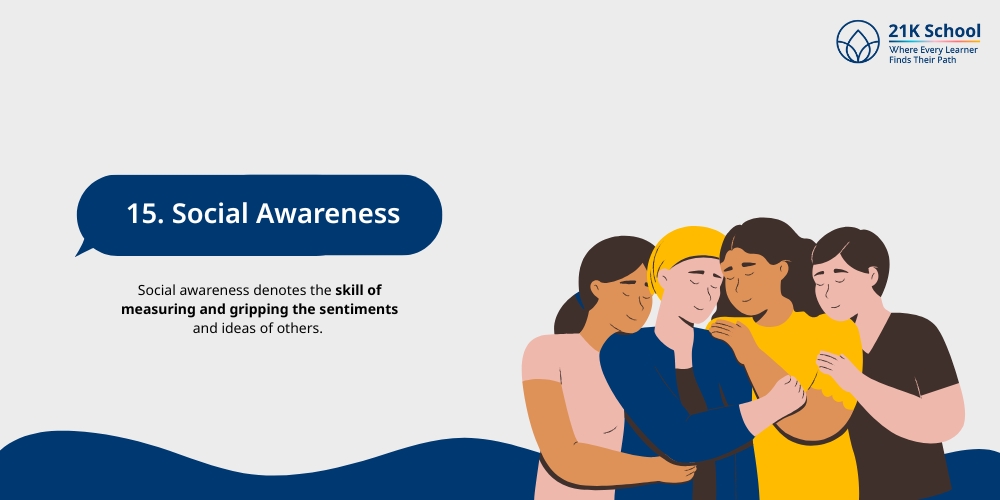
Social awareness denotes the skill of measuring and gripping the sentiments and ideas of others. Social awareness will teach students how to be empathic and to behave more adequately in the social environment.
Educators are able to promote discussions on how other people could feel under other circumstances. Healthy development of social consciousness and better relations with peers is also facilitated by role-playing situations.
This happens when students get to practice how to interpret the feelings of other people.
16. Role-Play Exercises
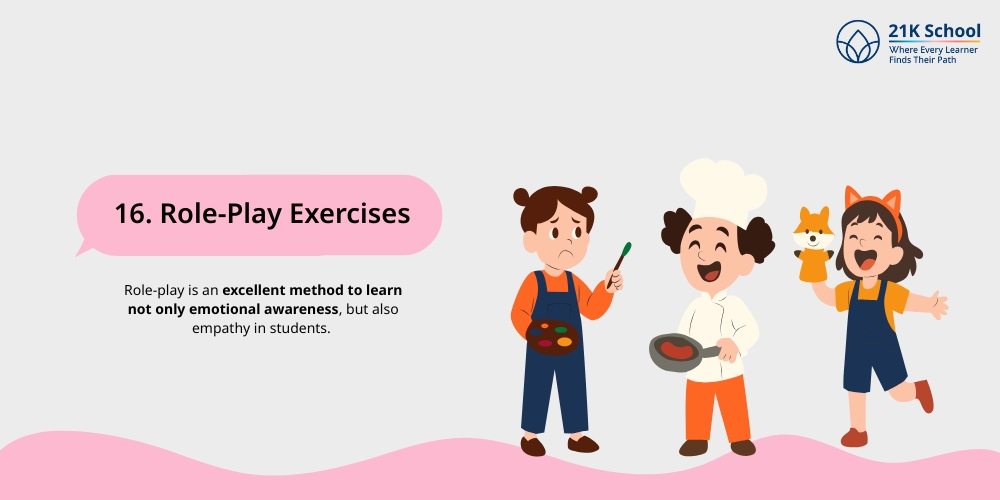
Role-play is an excellent method to learn not only emotional awareness, but also empathy in students. Students get to experience life in the eyes of another alternate character or perspective in the instance of role-play activities.
As an example, students can act out contention among friends and train with expressions of emotion to solve the dispute. This allows them time to practice how to express emotions properly and apply strategies of problem-solving in real life.
17. Emotional Story Telling
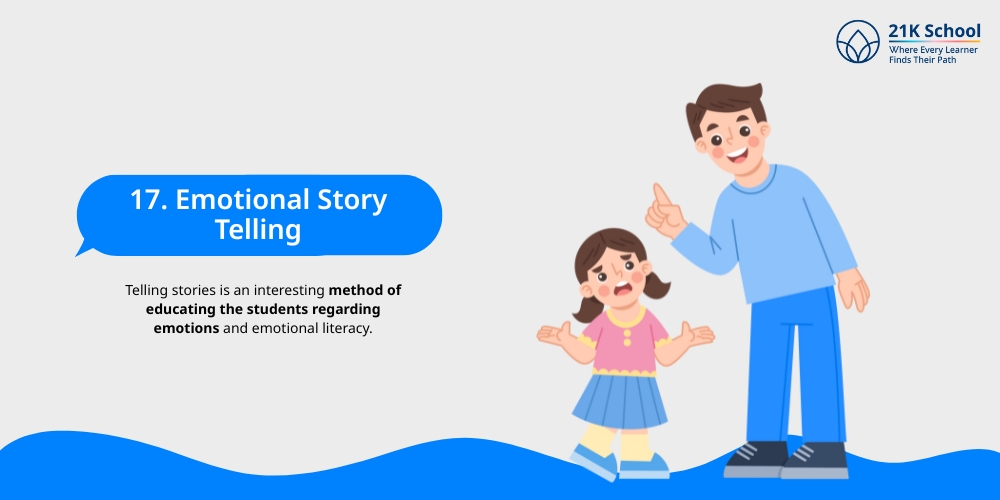
Telling stories is an interesting method of educating the students regarding emotions and emotional literacy. Teachers can read books or tell success stories in which the characters are pleased, saddened, frightened, or excited.
Subsequently, it is possible to discuss how the characters felt, why they felt this, and what the consequences were. This activity helps students connect emotionally with the characters and think critically about how emotions shape behavior and decisions.
The move makes the students emotionally engaged with the characters. It allows thinking about the role of emotions in shaping behaviors and choices.
18. Problem Solving
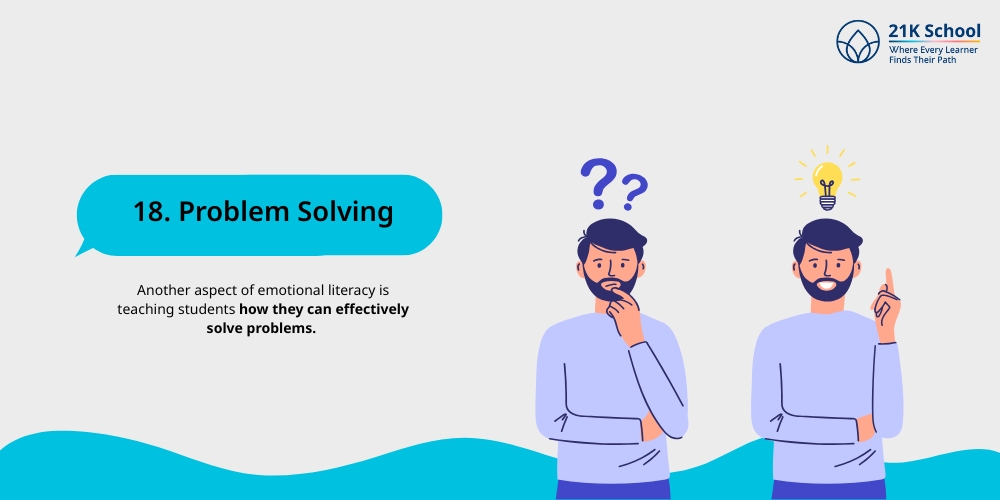
Another aspect of emotional literacy is teaching students how they can effectively solve problems. Students should learn to think calmly and solution-oriented to know how to control their feelings and overcome challenging situations.
The problem-solving techniques involved are problem identification, brainstorming, and assessment of impact of the actions. This can be guided by teachers. Such exercises will enable the students to learn self-control in order to concentrate on positive consequences.
Emotional Literacy vs Emotional Intelligence
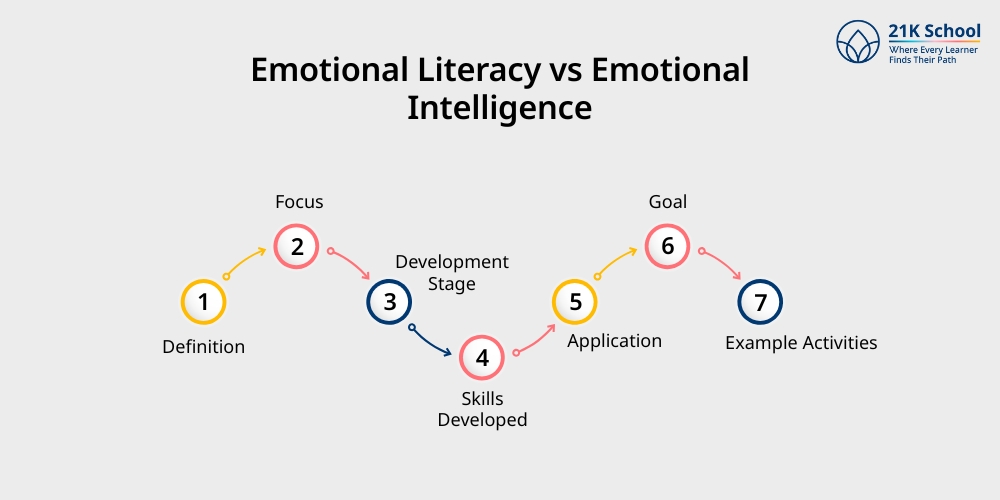
It is easy to argue that emotional literacy and emotional intelligence are two terms that are used interchangeably. Although they do not mean the same thing. Their differences and principal features are provided below:
| Aspect | Emotional Literacy | Emotional Intelligence (EI) |
| Focus | Recognizing, understanding, and expressing emotions. | Self-regulation, empathy, social skills, and emotional decision-making. |
| Target Audience | Primarily children, students, and those learning about emotions. | Applicable to both children and adults, especially in professional settings. |
| Application | Used in educational and developmental contexts. | Applied in workplaces, leadership, and personal relationships. |
| Skills Developed | Emotional awareness, vocabulary, and expression. | Self-awareness, empathy, conflict resolution, and leadership. |
| Goal | To help individuals identify and communicate emotions. | To build emotional skills for effective decision-making and relationship management. |
| Example Activities | Emotion charades, journaling feelings, labeling emotions. | Leadership training, conflict management, emotional regulation exercises. |
1. Definition
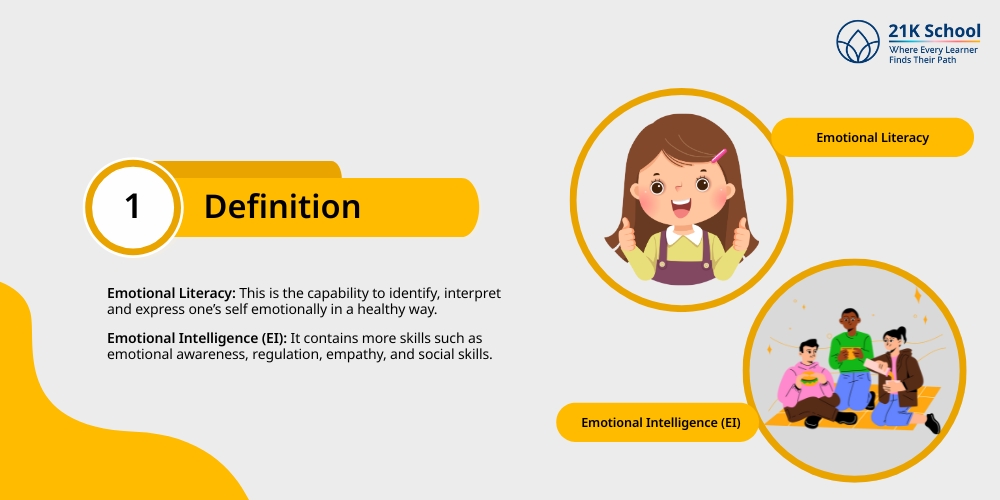
- Emotional Literacy: This is the capability to identify, interpret and express one’s self emotionally in a healthy way. It dwells on minimal emotional awareness and word usage in order to express emotions.
- Emotional Intelligence (EI): It contains more skills such as emotional awareness, regulation, empathy, and social skills. EI is not just about knowing emotions; it is about the way to deal and use them through diverse social and employment situations.
2. Focus
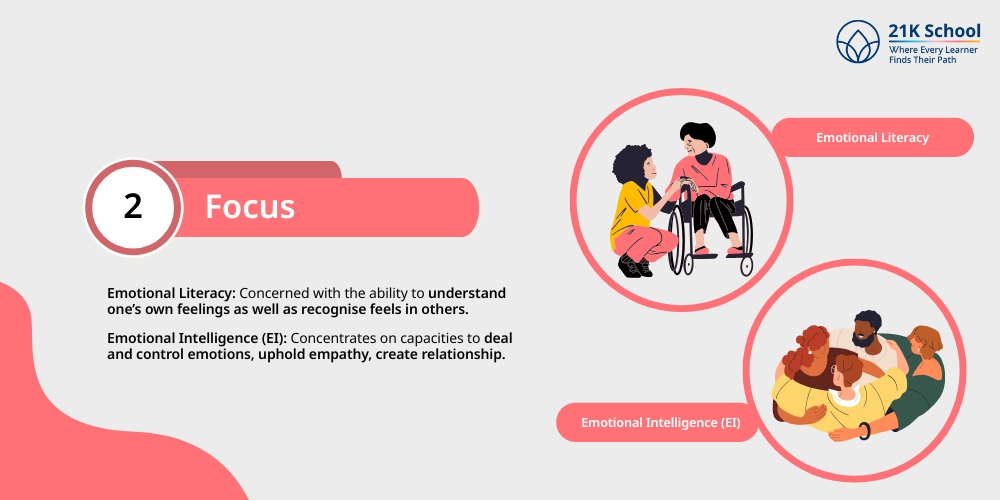
- Emotional Literacy: This area is mainly concerned with the ability to understand one’s own feelings as well as recognise feels in others.
- Emotional Intelligence (EI): Concentrates on capacities to deal and control emotions, uphold empathy, create relationships and make emotional decisions within probing social conditions.
3. Development Stage
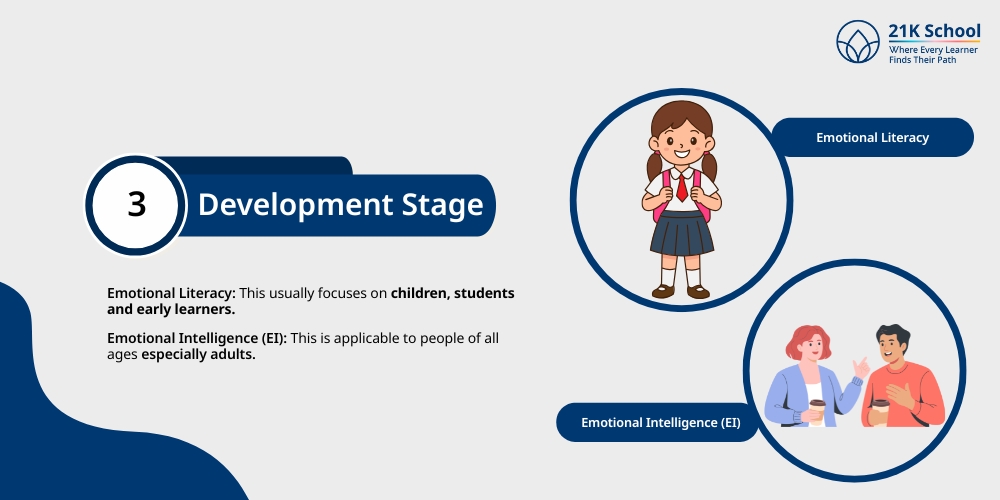
- Emotional Literacy: This usually focuses on children, students and early learners in order to enable them to learn the very basic emotion awareness and communication.
- Emotional Intelligence (EI): This is applicable to people of all ages especially adults in professional, leadership and management situations at work.
4. Skills Developed
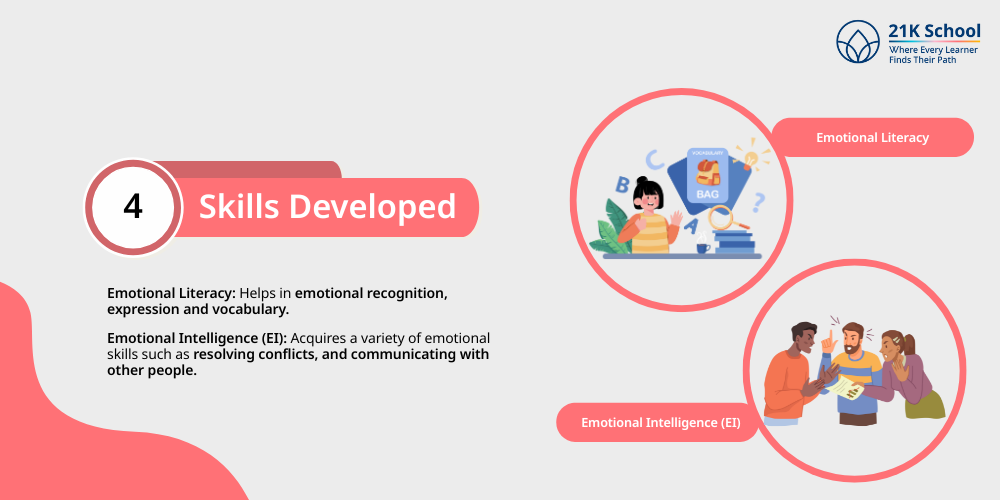
- Emotional Literacy: Helps in emotional recognition, expression and vocabulary. It pays attention to empathy and emotion expression.
- Emotional Intelligence (EI): Acquires a variety of emotional skills, such as emotional control, empathy, resolving conflicts, and communicating with other people.
5. Application
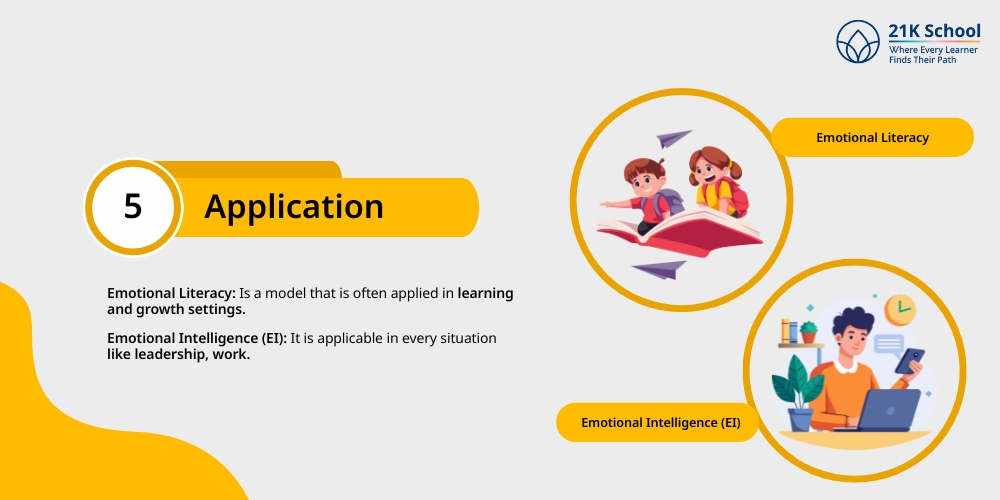
- Emotional Literacy: Is a model that is often applied in learning and growth settings to enable people to learn about and manage their emotions appropriately.
- Emotional Intelligence (EI): It is applicable in every situation like leadership, work, relation, and decision-making.
6. Goal
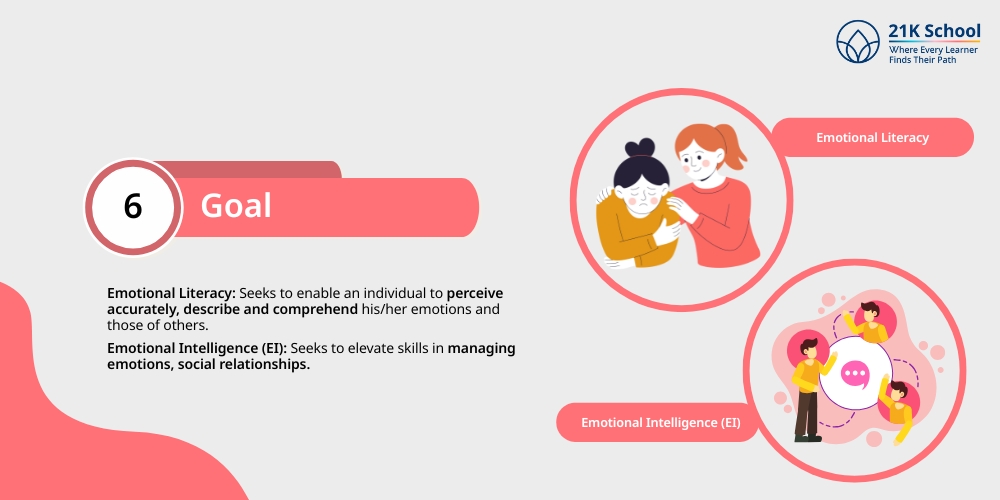
- Emotional Literacy: Seeks to enable an individual to perceive accurately, describe and comprehend his/her emotions and those of others.
- Emotional Intelligence (EI): Seeks to elevate skills in managing emotions, social relationships and utilizing emotional intelligence to realize a positive outcome in life and work.
7. Example Activities
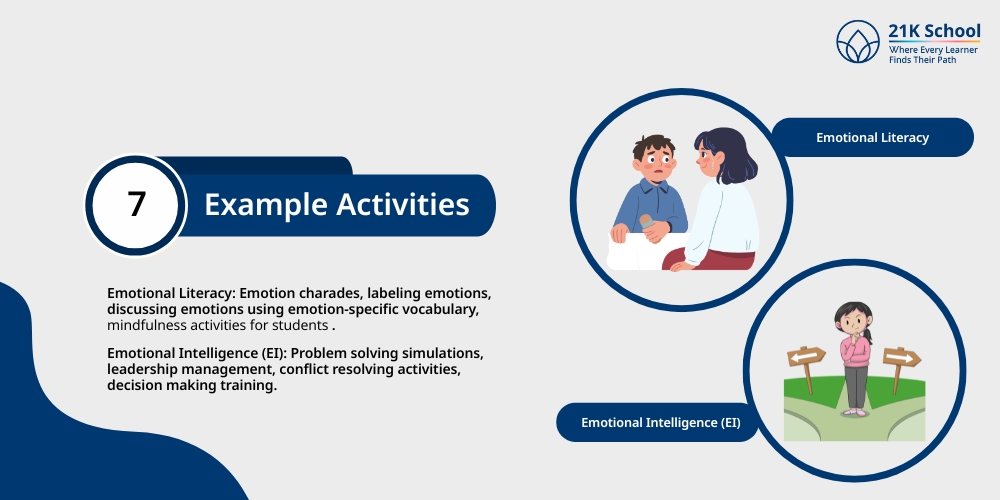
- Emotional Literacy: Emotion charades, labeling emotions, discussing emotions using emotion-specific vocabulary, mindfulness activities for students .
- Emotional Intelligence (EI): Problem solving simulations, leadership management, conflict resolving activities, decision making training.
Challenges and Barriers of Emotional Literacy
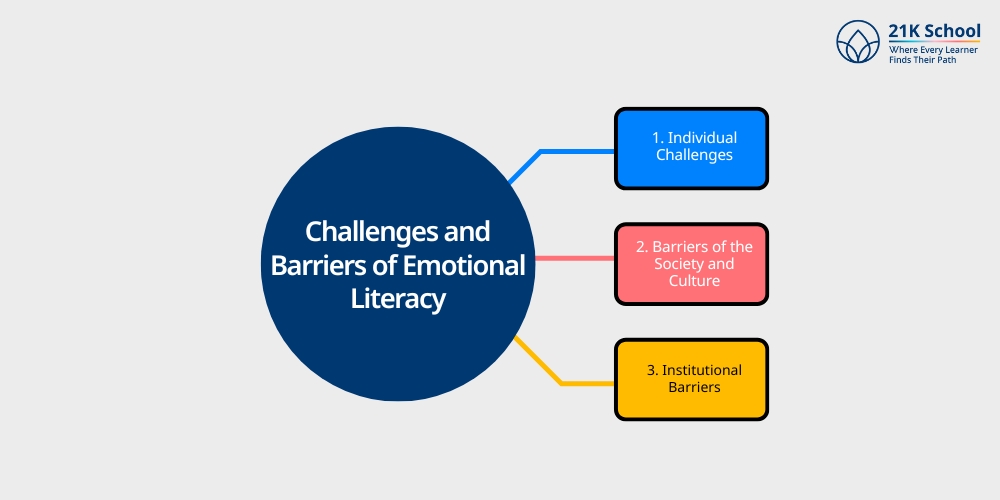
Although emotional literacy is advantageous, there are a couple of obstacles that may hinder its practice. These are barriers which can be personal, social or institutional.
1. Individual Challenges
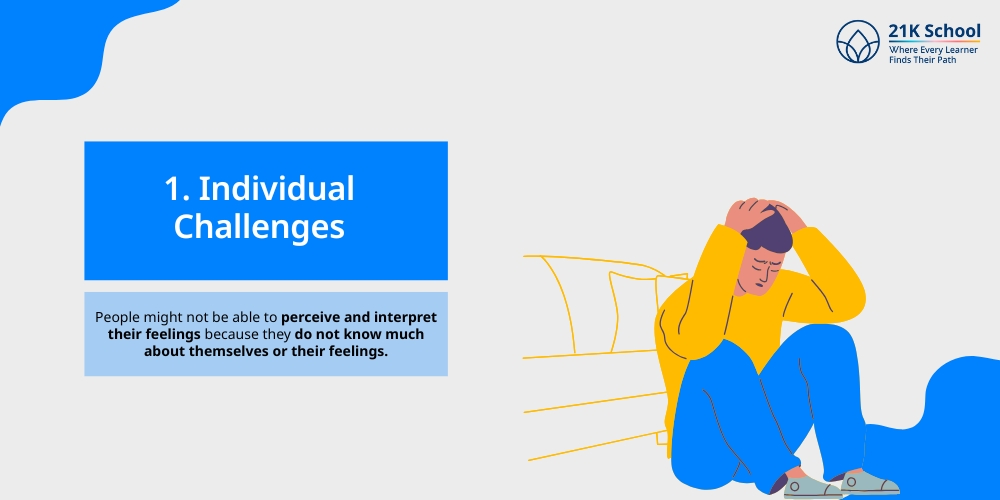
- Emotional Awareness: People might not be able to perceive and interpret their feelings because they do not know much about themselves or their feelings.
- Small Emotional Vocabulary: Having a narrow emotional vocabulary may make one have a hard time when conveying their emotions correctly.
- Emotional suppression: The norms of the culture or family may discourage the free expression of emotions, which results in suppression of emotions.
- Cognitive and Emotional Disabilities: Examples include autism, ADHD, or other emotional disorders that might create some difficulties when it comes to recognizing and managing emotions.
- Stress and Trauma: Individuals with trauma or persistent stress might not be effective in recognizing or controlling their emotions.
2. Barriers of the Society and Culture
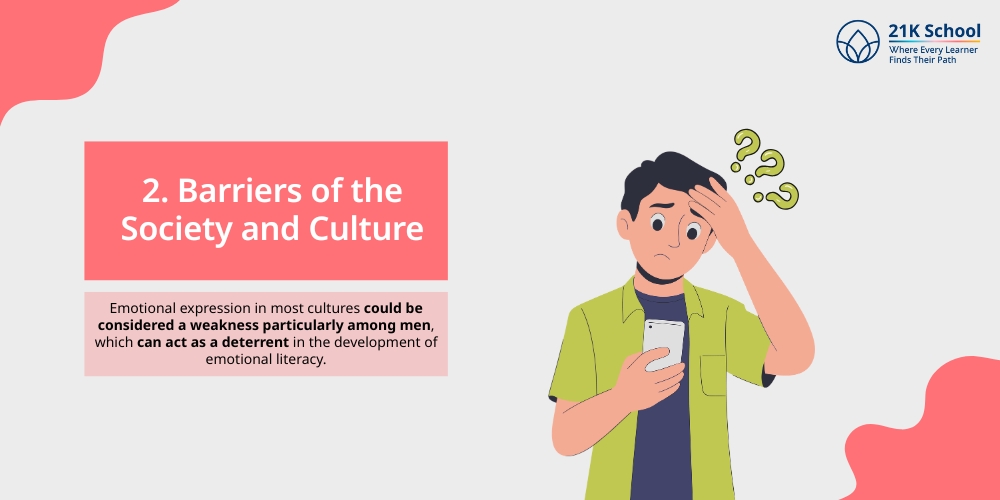
- Cultural Norms: Emotional expression in most cultures could be considered a weakness particularly among men, which can act as a deterrent in the development of emotional literacy.
- Social Stigma: Individuals can be afraid to be judged when displaying some vulnerable emotions, resulting in emotional repression and avoidance.
- Educational Gaps: Several systems of education train mainly on academic skills, and may not emphasize on their emotional growth thereby rendering students unable to identify and deal with their reactions.
3. Institutional Barriers
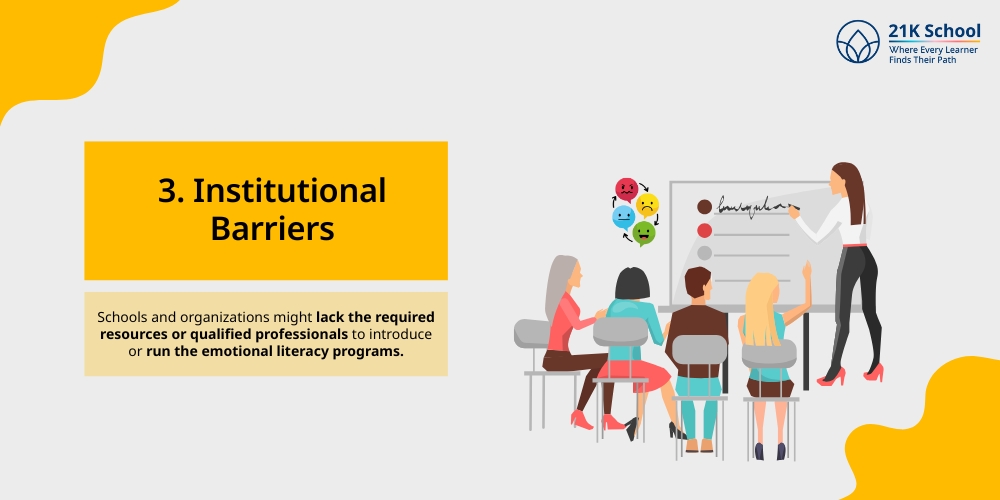
- Shortage of Resources: Schools and organizations might lack the required resources or qualified professionals to introduce or run the emotional literacy programs.
- Excessive Valuation of Cognitive Skills: Disproportionate attention to cognitive intelligence (IQ) at school and the place of work contributes to the deficit of emotional intelligence training. Read on how to develop cognitive skills for children .
- Job Requirements: The requirements of work life and the need to deliver and meet deadlines may not afford time to express or work on emotion, which can be an obstruction to harnessing emotional literacy.
Applications of Emotional Literacy in Real Life
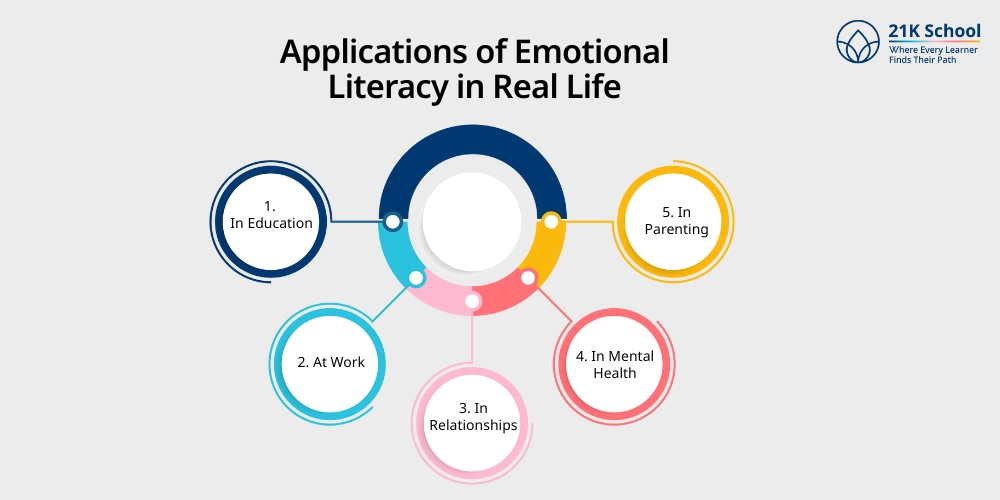
Not only is emotional literacy far more than a stare-gazing renovation program, it is also more than a piece of imaginable stairs.
1. In Education:
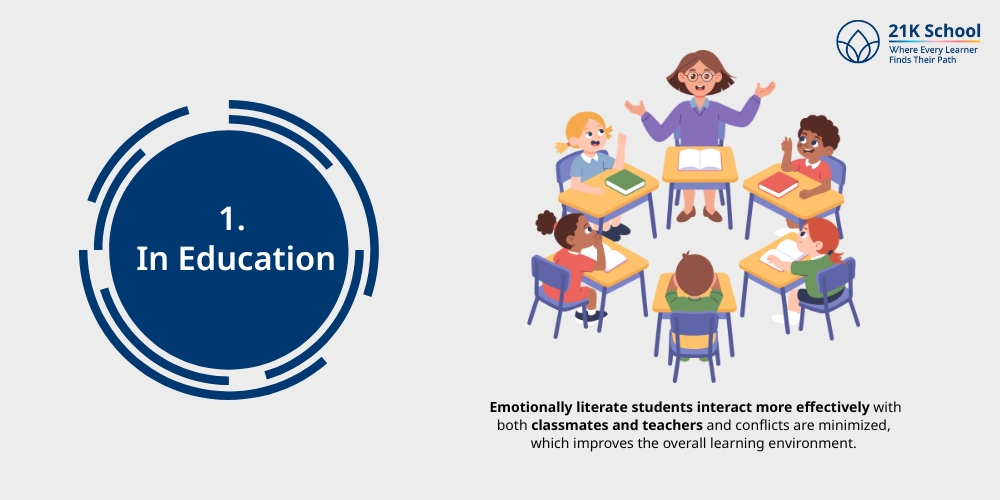
- Better classroom environment: Emotionally literate students interact more effectively with both classmates and teachers and conflicts are minimized, which improves the overall learning environment.
- Academic Success: Stress, anxiety, and frustration are better managed by emotion literate students, which increases focus and academic outcomes.
- Conflict Resolution: Students who are self aware and know the emotions of others can resolve conflict situations more effectively.
2. At Work:
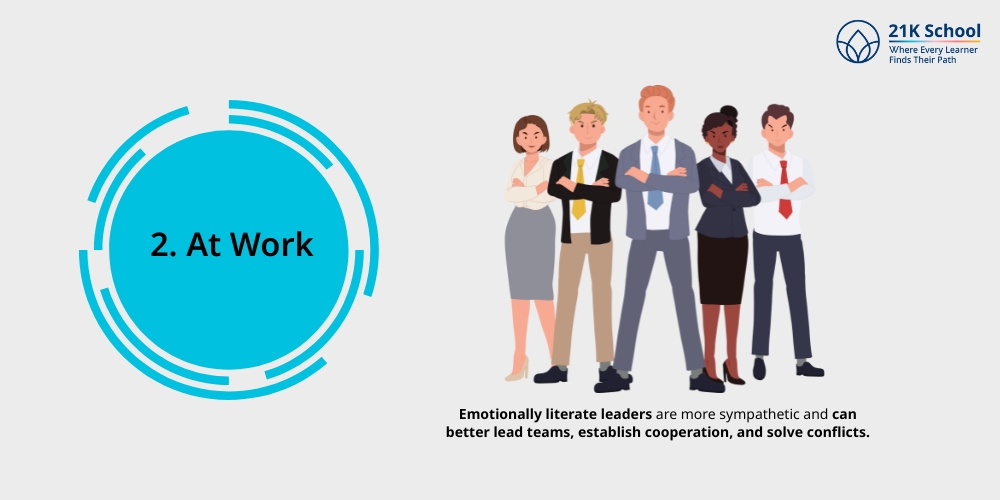
- Leadership Development: Emotionally literate leaders are more sympathetic and can better lead teams, establish cooperation, and solve conflicts.
- Stress management: Emotionally literate employees also manage stressful situations, and deal better with pressure, resulting in high performance and job satisfaction.
- Better communication: Emotional literacy can enhance communication between employees and make them work together, avoiding confusion at the workplace.
3. In Relationships:
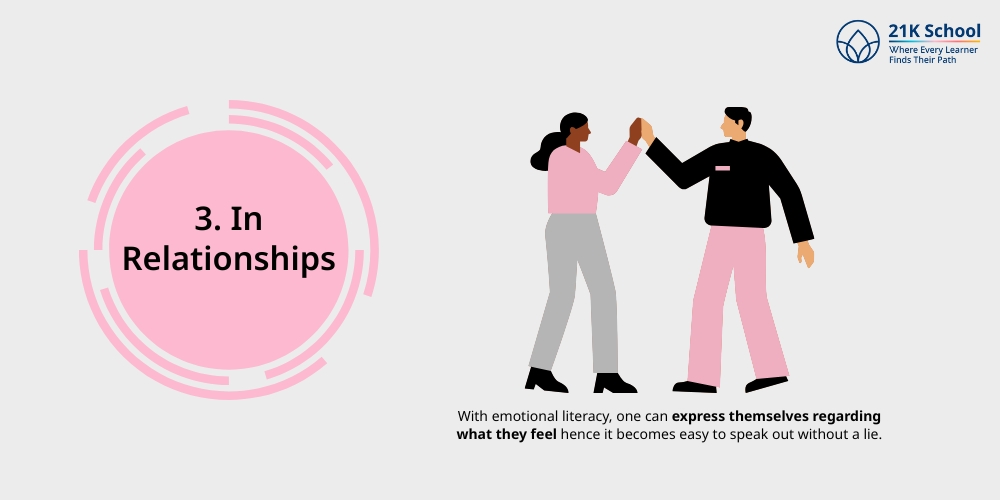
- Improved Communication: With emotional literacy, one can express themselves regarding what they feel hence it becomes easy to speak out without a lie.
- Greater Empathy: Empathy is a central element of emotional literacy, creating kinder and more understanding relationships.
- Conflict Resolution: Individuals who have emotional literacy are more able to combat conflicts without being angry or passive-aggressive.
4. In Mental Health:
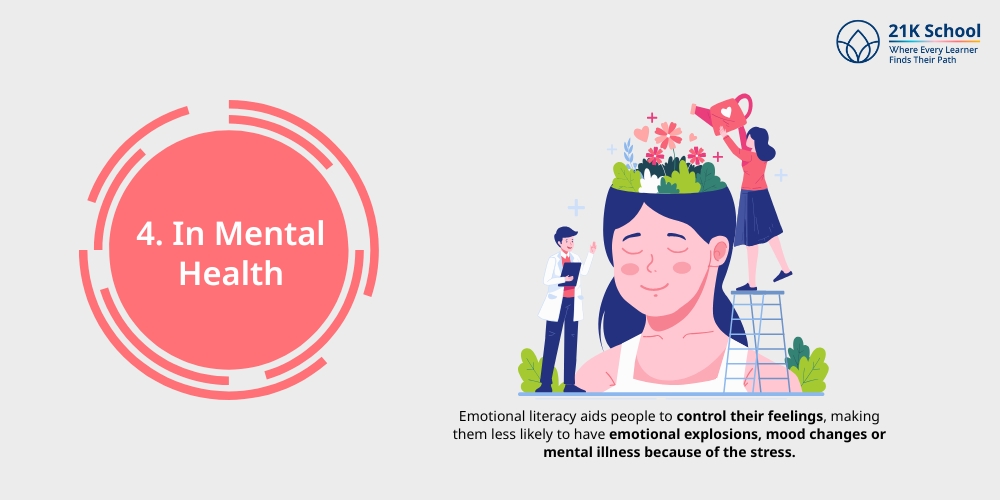
- Self-Regulation: Emotional literacy aids people to control their feelings, making them less likely to have emotional explosions, mood changes or mental illness because of the stress.
- Creating Resilience: Emotionally literate individuals can better avoid being affected by adversity and recover after failures faster; moreover, they better maintain emotional positivity.
5. In Parenting:
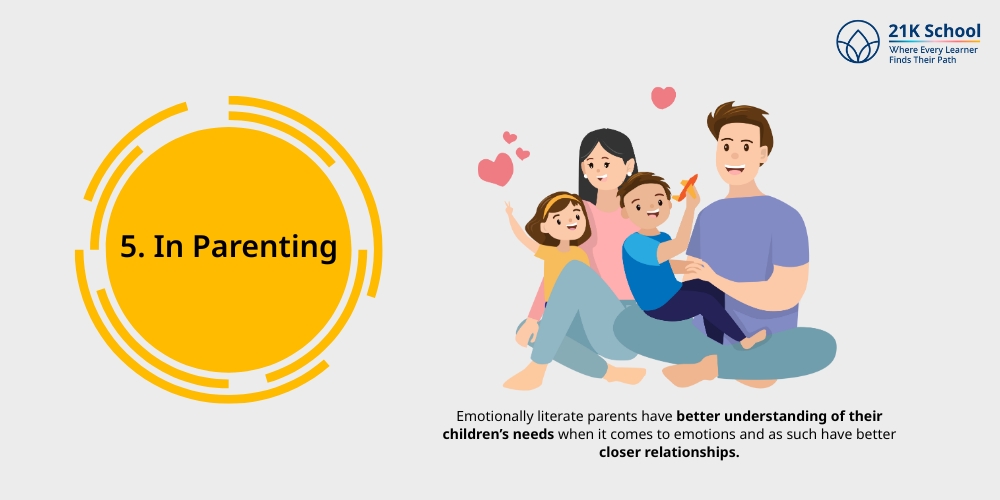
- Parent-Child Relationships : Emotionally literate parents have better understanding of their children’s needs when it comes to emotions and as such have better closer relationships.
- Emotional Skills Modeling: Parents do exemplify good emotional practices teaching children how to live a lifetime.
Conclusion
Emotional literacy is one of the basic life skills not taught in schools . It enables one to learn, communicate, and manage their emotions properly.
It assists in the fostering of well-being, communication, and relationship-building, both in the classroom, home, or work environments.
When we teach emotional literacy early, and reinforce it throughout life, we create emotionally literate people. They are better able to deal with life and find meaningful connections with others.
Although people might have set-backs including lack of exposure or stigma. One can develop emotional literacy at any age, by consciously practicing mindfulness, empathy training, and listening.
Contrary to emotional intelligence, emotional literacy focuses on communication and self-expression. With the world becoming more emotionally sophisticated, emotional literacy will be a good investment into a more caring, emotionally stronger world.

